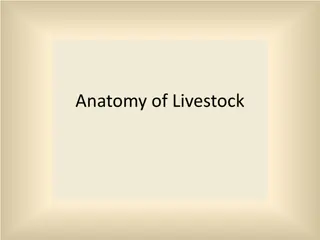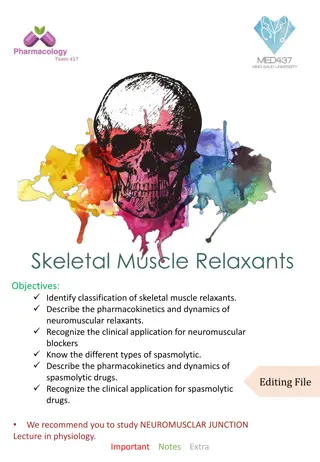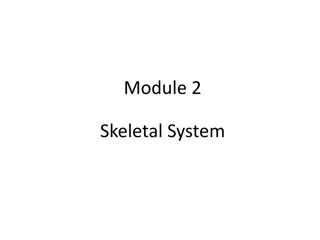Understanding the Nervous System: CNS, PNS, SNS, and ANS
The nervous system comprises the Central Nervous System (CNS) and Peripheral Nervous System (PNS), with the PNS further divided into the Somatic Nervous System (SNS) and Autonomic Nervous System (ANS). The SNS controls voluntary movements of skeletal muscles, while the ANS regulates involuntary proc
2 views • 23 slides
The muscular system
The muscular system is a vital organ system that includes smooth, skeletal, and cardiac muscles. It plays a crucial role in locomotion, supporting the cardiovascular system, enabling lung ventilation, regulating fluids, maintaining posture, and generating heat in the body. This system consists of ar
2 views • 16 slides
Skeletal Muscle Relaxants and Neuromuscular Blockade
Skeletal muscle relaxants are used to induce muscle relaxation during surgeries. Neuromuscular blocking agents act at the neuromuscular junction. These drugs can either peripherally reduce muscle tone or centrally cause muscle paralysis. Different types of muscle relaxants are classified based on th
6 views • 23 slides
Bone Fractures
Bone fractures can occur due to external forces, high-energy trauma, bone fatigue, or underlying skeletal diseases. Symptoms include pain, tenderness, swelling, and difficulty moving. Different types of fractures include nondisplaced, displaced, compound, pathological, longitudinal, and spiral fract
0 views • 15 slides
Best Knee Replacement Surgeons in India
Knee is the largest joint of the human body, it is a hinge joint which allows flexion and extension and also slight internal and external rotation. It connects our thigh to our lower leg. Similar to all other joints, the knees are part of our skeletal system. The knee helps to support our weight. It
0 views • 2 slides
Understanding Livestock Anatomy and Body Systems
Explore the anatomy of livestock, including the form, structure, and systems of the body. Learn about the skeletal, muscular, sensory, nervous, circulatory, respiratory, digestive, urinary, and reproductive systems. Discover body cavities, directions, and different systems and understand the functio
0 views • 34 slides
Exploring the Human Skeletal System
The skeletal system is crucial for protecting organs, providing structure for movement, storing minerals, and producing blood cells. It consists of the axial and appendicular skeleton, with bones classified into long, short, flat, and irregular shapes. Long bones, such as the femur, play a key role
2 views • 28 slides
Skeletal Muscle Relaxants: Classification, Pharmacokinetics, and Clinical Applications
Skeletal muscle relaxants encompass different types, including neuromuscular blockers, spasmolytic drugs, and peripherally-acting agents. They are classified based on mechanisms of action and play crucial roles in inducing skeletal muscle relaxation for various clinical applications. Understanding t
3 views • 12 slides
Overview of Veterinary Anatomy: Ox Skeletal Structure
Explore the intricate skeletal structure of an ox focusing on the digits, phalanges, and joints such as the fetlock and pastern. Dive into the detailed descriptions of the first and second phalanges, their surfaces, and articulations. Gain insights into the unique characteristics of the accessory di
1 views • 21 slides
Overview of Heterotopic Ossification in Medical Science
Heterotopic ossification (HO) is a phenomenon where bone forms in soft tissues outside the skeletal system. Initially observed in children with myositis ossificans progressiva, HO has been linked to trauma, neurogenic factors, and hereditary conditions like myositis ossificans progressiva. Clinicall
0 views • 44 slides
Understanding Fluorosis: A Critical Health Concern in Endemic Regions
Fluorosis, a prevalent condition in parts of India, China, Tanzania, and South Africa, affects millions due to high fluoride levels in drinking water. It manifests as dental and skeletal fluorosis, causing various symptoms based on exposure levels. Dental fluorosis leads to enamel discoloration and
0 views • 10 slides
Understanding the Function of Muscles - Our Amazing Muscular System
Our muscles play a vital role in our bodies by helping us move, pump blood, digest food, and breathe. They are made up of muscle fibers and connected to bones by tendons. The muscles work by contracting and relaxing when we move. To keep our muscles healthy, it's important to engage in physical acti
0 views • 6 slides
Understanding the Histological Structure of Muscle Cells
This presentation delves into the histological structure of three types of muscle cells - skeletal, cardiac, and smooth muscles. Learn about their differences, such as striation, voluntary vs. involuntary control, and cellular organization. Discover the components of muscular tissue, the coverings o
0 views • 13 slides
Understanding Osteology: An Overview of Bone Structures and Skeleton Composition
Osteology is the study of anatomical structures such as bones, cartilages, and the skeleton that support and protect the body. It includes the classification of bones based on shape and function, details on bones of the thoracic and pelvic limbs, and the divisions of the skeleton into axial, appendi
0 views • 15 slides
Comprehensive Guide to the Skeletal System
Explore the fascinating world of the skeletal system, including types of bone, bone formation processes, fractures healing, axial and appendicular skeleton, joints classification, and detailed insights into various types of joints. Dive into the anatomy of the pelvis, paranasal sinuses, and the shou
0 views • 20 slides
Visual Guide to Human Anatomy and Systems
Explore detailed images of human body parts and systems including face, thigh, head, hair, eye, nose, mouth, chest, arm, elbow, hand, leg, knee, foot, forehead, neck, ear, lip, tongue, tooth, teeth, finger, waist, calf, muscle-skeletal system, skull, shoulder, rib, spinal cord, hip, limbs, joints, a
0 views • 21 slides
Understanding the Human Skeletal System
Explore the functions of the skeletal system, learn about the various types and main bones, understand the importance of bone health, and discover the divisions of the skeleton - axial and appendicular. Dive into the intricacies of bone structure, functions, and how bones support, protect, and enabl
0 views • 12 slides
Understanding the Muscular System: Functions & Importance
Muscles are essential for movement, posture, circulation, and digestion in the human body. Without a properly functioning muscular system, vital processes like breathing and food digestion would be compromised. Maintaining muscle health through exercise and a nutritious diet is crucial to ensure opt
0 views • 11 slides
Comparative Anatomy of Mammals: Vertebral and Skeletal Structures
Explore the variations in vertebral formulae, rib pairs, rib shaft characteristics, scapula morphology, humerus features, ulna differences, and metacarpals/digits among horse, cattle, pig, sheep, dog, and fowl. Detailed images and descriptions offer insights into the distinct skeletal structures of
0 views • 9 slides
Exploring Human Bones: An Introduction to the Skeletal System
In this unit, you will delve into the fascinating world of human bones. From the skull to the legs, discover the vital roles each bone plays in our body. Learn about the human skeleton, identify important bones, and understand the functions of key body parts. Engage with interactive activities and b
0 views • 10 slides
Exploring the Human Skeletal System
The skeletal system plays crucial roles in supporting the body, protecting internal organs, facilitating movement with muscles, and producing blood cells. It consists of various bone structures like periosteum, compact bone, spongy bone, and bone marrow. The cranium houses important bones such as th
0 views • 53 slides
A Comparison of Human and Frog Anatomy and Physiology
Humans and frogs share many similarities in their organ systems such as lungs, digestive, circulatory, skeletal, and muscular systems. However, there are also significant differences in body configuration, respiratory system, skeletal structure, and reproductive system. Frogs have unique features li
0 views • 7 slides
Understanding Neuromuscular Transmission and Drug Effects on Frog Rectus Abdominis
The content explores the neuromuscular transmission process in frog rectus abdominis, focusing on the release of Ach and its effects on Nm receptors. It also discusses the impact of different drugs on skeletal muscles, both centrally and peripherally acting, including those that act presynaptically
0 views • 12 slides
Understanding the Muscular System and Its Anatomy
The muscular system is vital for movement, posture maintenance, and organ protection. It consists of skeletal muscles that contract to create movement, circular muscles called sphincters for controlling openings, and muscle fibers arranged in fascicles with collagen layers like epimysium and endomys
0 views • 59 slides
Understanding the Anatomy of the Skeletal System
Explore the two major sections of the skeletal system: the Axial Skeleton, which provides protection to vital organs, and the Appendicular Skeleton, enabling movement. Discover variations in bone structure across species, from horses to dogs, and delve into the bones of the Axial Skeleton, including
0 views • 29 slides
Understanding the Musculoskeletal System in the Human Body
The musculoskeletal system, comprising the muscular and skeletal systems, supports body movement, stability, and shape. It includes muscles, bones, tendons, ligaments, and joints. This system serves functions like providing support, protection to vital organs, mediating movement, and producing blood
0 views • 36 slides
Overview of Mammalian Respiratory System Histology
The respiratory system in mammals functions to warm, humidify, and cleanse the air as it travels from the nostrils to the lungs. It comprises the nasal cavity, pharynx, larynx, trachea, bronchi, and bronchial tree. The epithelial linings vary in different parts, containing specialized cells and glan
0 views • 14 slides
Understanding Skeletal Muscle Relaxants and Muscle Contraction Mechanisms
Skeletal muscle relaxants play a crucial role in relaxing muscles without affecting consciousness significantly. They are classified into neuromuscular blockers and spasmolytics, each targeting different mechanisms in the body. Muscle contraction occurs through the release of acetylcholine and the s
0 views • 27 slides
Understanding General Embryology: Germinal Layers and Organ Formation
General embryology covers the development of organs and tissues from the three germinal layers - ectoderm, mesoderm, and endoderm. Ectoderm gives rise to the nervous system and body covering, mesoderm forms skeletal tissue and muscles, while endoderm forms the gut lining. Derivatives of each layer i
0 views • 10 slides
Understanding Connective Tissue Wrappings and Skeletal Muscle Structure
Exploring the connective tissue wrappings and attachments of skeletal muscles, this content highlights the cord-like structures, collagen fibers, and their role in connecting muscle bellies to bones. It also delves into the surrounding connective tissues such as fascia, epimysium, perimysium, and en
0 views • 11 slides
Veterinary Anatomy: Tarsal Bone Structure and Function
The veterinary anatomy lesson delves into the intricacies of the tarsal bone in oxen, detailing its composition, arrangement of short bones, and specific features like the tuber calcis and articulation points. The tarsus comprises different rows of bones, each serving a specific function in locomoti
0 views • 24 slides
Overview of Muscle Disorders and Muscular Dystrophies
The human body consists of over 600 muscles, divided into skeletal, smooth, and cardiac muscles. Diseases of skeletal muscle encompass myopathy, myositis, and muscular dystrophy. Muscle disorders are categorized into genetic muscular dystrophies, channelopathies, inflammatory myopathies, and endocri
0 views • 32 slides
Unveiling the Intrigues of Skeletons: Explore, Learn, and Engage
Delve into the world of skeletons through a series of engaging activities including learning about 10 intriguing facts, contemplating on the significance of bones in human life, and exploring hypothetical scenarios regarding life without bones. Participate in interactive sessions to identify parts o
0 views • 9 slides
Understanding Animal Skeletal System: Importance and Components
The skeletal system in animals plays a crucial role in providing structural support, facilitating movement, and offering protection to vital organs. It is composed of various components like bones, joints, ligaments, tendons, compact bone, and spongy bone. Different types of bones in an animal's bod
0 views • 13 slides
Exploring Human Skeleton Anatomy: Bones, Structure, and Functions
Delve into the intricate details of the human skeleton, including the organization of bones in the axial and appendicular skeletons. Learn about the different bones comprising the skeletal system, their functions, and the significance of memorizing 144 bones. Discover learning objectives related to
0 views • 8 slides
Introduction to Anatomy: Anatomical Terms and Skeletal System
An introduction to anatomy covering anatomical terms and the skeletal system. It defines anatomy, explains anatomical sciences, discusses the skeletal system, and outlines anatomical terminology including terms of position. The content includes objectives, classifications of bones, and different ana
0 views • 28 slides
Understanding the Musculoskeletal System and Common Bone Disorders
The musculoskeletal system comprises bones, joints, ligaments, cartilage, and muscles, with the skeleton providing support, protection, and enabling movement. Learn about the functions of the skeletal system, its divisions, and common bone diseases such as osteoporosis and fractures.
0 views • 8 slides
Development of Head and Neck Mesenchyme in Embryonic Formation
The formation of the head and neck region in embryonic development involves mesenchyme derived from paraxial mesoderm, lateral plate mesoderm, neural crest, and ectodermal placodes. Paraxial mesoderm contributes to brain case and muscle formation, while lateral plate mesoderm forms laryngeal cartila
0 views • 34 slides
Understanding Muscle Tissue: Structure and Function
Muscle tissue is a vital component in most animals, facilitating movement and maintaining posture. Derived from embryonic cells, muscles come in three types: skeletal, cardiac, and smooth, each serving specific functions in the body. While skeletal muscles are under voluntary control, cardiac and sm
0 views • 15 slides
Overview of Skeletal Muscle Relaxants and Neuromuscular Blockers
Skeletal muscle relaxants and neuromuscular blockers are important drugs used to induce muscle relaxation. They are classified based on their site of action and mechanism of action. Understanding their classification, pharmacokinetics, and clinical applications is crucial for medical professionals.
0 views • 25 slides







































